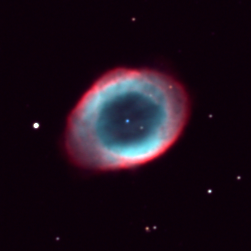A timeline of the process

If I could change one thing about my experience, I would have started
planning earlier! It is easier to remain organized the earlier you start, so
here is a loose timeline and suggested material that I would recommend when undertaking this endeavor.
It's important to note that everyone has a slightly different path to graduate school,
so take whichever parts of this that work for you.
Summer before your final academic year (July):
Start looking into potential programs at different schools.
Decide what you are looking to get out of a career post-undergrad. Are you enthusiastic about astronomy, physics, or even optics research?
Can you focus your interest into a subfield like exoplanets, galaxies, instrumentation etc?
This will help you narrow down a list of specific programs. At this point, it's important to note
that you don't want too small of a list either. An aspect that I believe can increase your chances of success is
being open to as many programs as possible. Graduate admissions is a numbers game and often seen as a crapshoot since so
many deserving people apply for so few spots.
The more programs you apply to
the more likely you are to be admitted to one! A caveat is that you should still be
happy with going to any of the schools on your list and there is no such thing as a safety school for graduate programs.
However, the application process is not accessible to everyone when application fees
can range from $50 to over $100. Therefore, it is important to apply for fee waivers.
This extra step can relieve a lot of economic stress
when it comes to applying.
Finally, this is the time to make your Curriculum vitae (CV) or updated it! A CV is an academic resume tailored to your academic
and research achievements (see below for an example).
Beginning of final academic year (August):
The beginning of the academic year is a great time
to ask for letters of recommendation. Most astronomy programs want three letters, so make sure
to give each letter writer as much time as possible to compose a strong letter. If you plan to apply
for the NSF graduate student fellowship, they will also ask for three letters of recommendation, so
reaching out to potential letter writers as early as possible is advantageous.
Sometimes, it can be difficult to think of three different people to ask for these letters, but a good place to start is asking your research advisors or
post-docs with whom you worked closely,
academic advisors (i.e. a professor who taught a class you were engaged in or maybe TA'ed for), or faculty sponsors for a club in which you
played a role. Sometimes the merit of the letter
is more powerful than the prestige of the person writing the letter. However, make sure they can write a strong letter for you.
Don't be afraid to keep
tabs on your letter writers' progress, especially when the deadline approaches!
Furthermore, now is a good time to cold email faculty at schools you are interested in to see if they plan on taking students.
There has been debate over whether this step is useful, but in my opinion the bare minimum this provides is an exercise in writing professional emails
and helps you narrow down which schools are top tier in your mind.
Taking the initiative to reach out to them has the potential of
showing how committed you are to the program and will allow you to narrow down potential faculty mentors as well. It's okay to be forward
and ask if they are planning on taking students!
Worst case scenario is that they don't respond, but trying will not hinder your potential.
You may also want to consider applying for the NSF graduate student fellowship. The application requires
a personal statement and a research proposal (see below for details), and the deadline is normally in October, so make sure to give yourself
plenty of time to prepare.
If you have previous research experience, it could be helpful to reach out
to your advisor to brainstorm research proposal ideas. If this is your first time writing a proposal, it may be daunting, so your advisor's expertise
is vital! There is no harm in applying for the NSF GRFP as an undergraduate student because if you don't receive the award,
you can always re-apply in graduate school, but you are allowed only one attempt once you are in a graduate program.
October:
This is normally when the NSF GRFP is due, so make sure all materials for that are ready!
This is also a good time to start drafting a general graduate school personal
statement and statement of purpose. You can tailor it to each school when the deadline approaches.
If you applied for the NSF GRFP this should make drafting up your essays easier! Around this time is ideal to have
a solid list of schools you want to apply to.
October is also the deadline to submit an abstract to the American Astronomical Society
(AAS) where you may showcase the work you did in undergrad via a poster or a short talk!
It's also a great place to network and get a sense of the cutting-edge research being
conducted in the field.
Should you take the Graduate Records Exam (GRE)? Since the beginning of the pandemic in 2020, most programs have stopped
requiring the general GRE and the physics GRE. Studies have shown that standardized test scores do not correlate to success in a PhD program, and therefore
many schools make the test optional. The main reason one would take the test is if they earned their bachelor's degree in a
completely different field and wanted to prove their readiness for a physics-based program. If you are planning to earn a bachelor's degree in
a physics related field and decide to
not take the GRE, your chances will not be hurt when applying to schools where the GRE is optional.
November:
Now would be a good time to ask for feedback on application materials. You can ask
your letter writers, and current graduate students in your department! Also, see if your current institution is holding
workshops and editing sessions for graduate school application materials. This is also the time to start tailoring your
statements to specific schools. Beware of different word/character limits for different schools!
Reaching out for fee waivers at the programs you want to apply to around this time is also favorable.
December:
Time to polish up statements, update your CV once more, confirm your letters of recommendation
are ready, and... time to submit! Most applications are due in the first half of December depending on the school.
CONGRATS you made it through this long and demanding process!! The application process can be an exhausting time period, so it is commendable to put in such effort!
Some schools will also have an interview stage in January or early February. Most of the time they will give you the questions they will ask in advance
to allow you to prepare. These questions will be related to previous research you've conducted and what research you want to do in the future.
Make sure to prepare questions to ask them in return.
Decisions normally happen between January and March depending on the program.
In January, the winter American Astronomical Society (AAS) meeting is also a place to make connections with fellow astronomers and present your work.
Since abstracts for posters/talks are submitted before the admissions deadline, you can talk about attending the meeting in your application!
I strongly recommend having an
organization system
to keep track of programs you are interested in,
and it benefits your letter of recommendation writers so they can also tailor their letters to the different programs!
Below are some helpful resources to start choosing PhD programs and also what my CV looked like when applying to
graduate programs.
